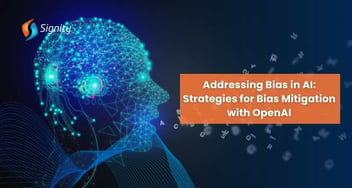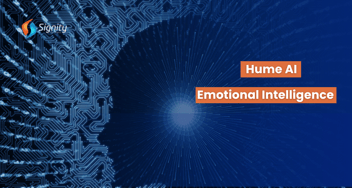What is Artificial Intelligence (AI)? A Beginner’s Guide
Artificial Intelligence (AI) is revolutionizing daily life, from virtual assistants to recommendation algorithms. This blog explores AI's definition, historical roots, and its vital role today. It delves into types of AI, how it works, and diverse applications and offers guidance for those intrigued by this dynamic field.
.jpg?width=670&height=445&name=What%20is%20Artificial%20Intelligence%20(AI).jpg)
Artificial Intelligence (AI) is a rapidly evolving field that has become an integral part of our daily lives. At its core, AI refers to the development of computer systems that can perform tasks that typically require human intelligence. This includes learning, problem-solving, understanding natural language, and even visual perception.
The importance of AI in today's world cannot be overstated, as it permeates various aspects of our everyday lives, from virtual assistants on our smartphones to sophisticated algorithms powering online recommendation systems. To truly understand AI, let's delve into its definition, historical context, and its pervasive impact on society.
What is Artificial Intelligence?
Artificial Intelligence (AI) refers to the simulation of human intelligence processes by machines, especially computer systems. It encompasses various capabilities, including expert systems, natural language processing, speech recognition, and machine vision.
These tasks encompass a broad spectrum, from recognizing speech and understanding language to visual perception and decision-making.
Importance and Prevalence of AI in Everyday Life
The prevalence of AI in our daily lives is undeniable. From voice-activated personal assistants like Siri and Alexa to the algorithms that power social media feeds and online shopping recommendations, AI has seamlessly integrated into our routines. The convenience it brings is matched only by its ability to streamline complex processes, making AI a key player in various industries.
Brief History of Artificial Intelligence (AI)
The roots of AI can be traced back to ancient times, but the formal exploration of AI as a field of study began in the mid-20th century. However, the modern development of AI began in the 1940s and 1950s. In 1940-1960, the birth of AI was strongly marked by the conjunction of technological developments and the link between AI and computing.
In 1950, Alan Turing published "Computing Machinery and Intelligence," which posed the question, "Can machines think?" This was a seminal work that marked the birth of the AI conversation.
In 1956, the field of AI research was founded at a workshop held at Dartmouth College, USA, and the term "artificial intelligence" was coined and came into popular use.
From 1957 to 1974, AI flourished, with significant progress in the field. The history of AI is essential in understanding its current state and future potential.
Understanding the historical context is crucial to appreciate the strides AI has made and continues to make.
Types of Artificial Intelligence (AI)
The types of Artificial Intelligence (AI) can be classified into different categories based on their capabilities and functionalities. Here's a little more elaboration on the types:
Based on Capabilities:
Narrow or Weak AI -
Narrow AI is designed to perform a specific task or a set of tasks. Examples include virtual personal assistants, speech recognition systems, and image recognition software. These systems are adept at the tasks they are programmed for but lack the versatility of human intelligence.
General or Strong AI -
General AI, often depicted in science fiction, refers to machines with the ability to understand, learn, and apply knowledge across a wide range of tasks, similar to human intelligence. Achieving true General AI remains a goal for the future.
Super AI -
Super AI goes beyond human intelligence, surpassing cognitive abilities in all respects. While still in the realm of theoretical discussion, its potential implications and ethical considerations fuel ongoing debates.
Based on Functionalities:
Reactive Machines -
These are the oldest forms of AI systems that have extremely limited capability. They can respond to different kinds of stimuli but do not have memory-based functionality.
Limited Memory -
AI that can use past experiences to inform future decisions. Examples include self-driving cars, which use past data to make decisions while driving.
Theory of Mind -
This is a type of AI that can understand the beliefs, intentions, and emotions of others. It is a more advanced form of AI that is currently in the realm of research and development.
Self-aware AI -
This is the most advanced form of AI, where machines have consciousness and self-awareness. This type of AI is currently a theoretical concept and is not yet realized in practice.
How Does Artificial Intelligence Work?
Artificial Intelligence (AI) works by combining large sets of data with intelligent, iterative processing algorithms to learn from patterns and features in the data. AI systems can perform thousands or even millions of tasks quickly, learning and becoming extremely capable at specific tasks.
Understanding how AI works involves exploring key concepts and technologies:
- Machine Learning: It is a subset of AI that enables machines to learn from data and improve their performance on a specific task without being explicitly programmed. It can be categorized into three types: supervised learning, unsupervised learning, and reinforcement learning.
- Deep Learning: Deep learning, inspired by the human brain's neural networks, involves the use of artificial neural networks to analyze and process data. It is particularly effective in tasks such as image and speech recognition.
- Neural Networks: These are a set of algorithms, modeled loosely after the human brain, that are designed to recognize patterns.
- Cognitive Computing: It is the simulation of human thought processes in a computerized model. Cognitive computing involves self-learning systems that use data mining, pattern recognition, and natural language processing to mimic the way the human brain works.
- Natural Language Processing (NLP): It enables machines to understand and interpret human language, facilitating communication between humans and computers. It powers virtual assistants, language translation, and sentiment analysis. Read More about what is Natural Language Processing (NLP)
- Computer Vision: It allows machines to interpret and make decisions based on visual data. Applications range from facial recognition to autonomous vehicles.
Applications of Artificial Intelligence (AI)
As AI contributes to diverse applications, one notable aspect is the integration of Text-to-Speech (TTS) technology. TTS transforms written content into realistic voiceovers, proving essential in creating engaging multimedia experiences. With its ability to generate voices in multiple languages swiftly, this AI-driven tool assists users from various fields by producing natural-sounding speech adaptable across digital platforms. It supports keeping audiences engaged through ultra-realistic narratives.
AI's impact is felt across various industries and creative domains Industries such as healthcare, finance, transportation, and manufacturing benefit from AI applications, improving efficiency, accuracy, and decision-making processes.
- Healthcare: AI is used in healthcare to build sophisticated machines that can detect diseases and analyze chronic conditions with lab and other medical data to provide better diagnosis and treatment options.
- Finance: AI is used in personal finance applications, such as Intuit Mint or TurboTax, to provide financial advice and collect personal data. AI software also performs much of the trading on Wall Street.
- Manufacturing: AI is used in manufacturing to automate tasks, optimize production processes, and improve quality control.
- Agriculture: AI is used in agriculture to identify defects and nutrient deficiencies in the soil, analyze where weeds are growing, and help harvest crops at a higher volume and faster pace than human laborers.
- Gaming: AI is used in gaming to create smart, human-like NPCs to interact with the players and predict human behavior, using which game design and testing can be improved.
- Robotics: AI is used in robotics to sense obstacles in its path and pre-plan its journey, carry goods, and perform other tasks.
Getting Started with AI
For those intrigued by AI and wishing to embark on the journey of understanding and implementing it, there are key steps to consider:
Learning AI Basics
Begin with a solid understanding of AI fundamentals, including machine learning algorithms, programming languages, and problem-solving approaches.
AI Tools and Programming Languages
Explore popular AI tools and programming languages such as Python, TensorFlow, and PyTorch, which are widely used in AI development.
Specialization in AI Areas
Considering the vastness of AI, specializing in specific areas such as natural language processing, computer vision, or robotics can provide a focused and rewarding career path.
Key Artificial Intelligence Statistics You Need to Know:
- The AI industry is experiencing rapid growth, with a projected annual average growth rate of 33.2% between 2020 and 2027.
- Global AI usage is expected to reach a potential market value of $190.61 billion by 2025.
- By 2030, AI is forecasted to contribute $15.7 trillion to the global economy.
- Currently, 35% of businesses have adopted AI, and 77% of devices in use feature some form of AI.
- It is estimated that by 2025, AI might eliminate 85 million jobs but create 97 million new ones, resulting in a net gain of 12 million jobs.
- The primary objective for integrating AI is to optimize internal business operations, as reported by 36% of executives.
- AI is utilized across various industries, including healthcare, finance, manufacturing, agriculture, gaming, and robotics.
Explore the World of AI: Start Your Journey Today!
Position yourself for success in the AI-driven world. Stay ahead of the competition by capitalizing on the growing demand for AI skills.
The Future of AI and Responsible Use
As AI continues to advance, several possibilities and challenges lie ahead:
Potential Future Developments in AI
Anticipated developments include advancements in natural language understanding, enhanced problem-solving capabilities, and the potential realization of General AI.
Ethical Considerations and Responsible Use of AI
The responsible development and deployment of AI are crucial. Ethical considerations, privacy concerns, and the impact on employment are areas that require ongoing attention and regulation to ensure AI benefits society responsibly.
Conclusion
The world of AI is vast and constantly evolving. From its historical roots to its diverse applications and potential future developments, understanding AI is a journey that requires an appreciation of its complexity and significance. As we embrace the power of AI in our lives, it is equally important to approach its development and use with a sense of responsibility and ethical consideration.
Whether you are a beginner curious about the basics or an aspiring AI enthusiast, this guide provides a solid foundation to navigate the exciting realm of Artificial Intelligence.
Frequently Asked Questions
Have a question in mind? We are here to answer. If you don’t see your question here, drop us a line at our contact page.
What is Artificial Intelligence (AI)?
![]()
AI refers to the simulation of human intelligence processes by machines, enabling them to perform tasks that typically require human intelligence.
How does AI impact our daily lives?
![]()
What are the types of AI?
![]()
What are the key technologies behind AI?
![]()
What are the applications of AI across industries?
![]()
How can I get started with AI?
![]()
What are the potential future developments in AI?
![]()
What are the ethical considerations in AI development and deployment?
![]()
How can I contribute to the responsible use and development of AI?
![]()


%201-1.webp?width=148&height=74&name=our%20work%20(2)%201-1.webp)


.png?width=344&height=101&name=Mask%20group%20(5).png)



















